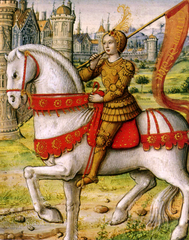
The indisputable highlight of July is one day of patriotic fireworks, parades, and red-white-and-blue flags waving in national fervor. I’m speaking, of course, of July 14—Bastille Day, the most important holiday in France. So crank “La Marseillaise” and allow quiz show champ Ken Jennings to help you out with his formidable! knowledge of all things French.
French Myth #3: Joan of Arc was from France.
Joan of Arc, the peasant girl who helped lead resistance to the English in the Hundred Years’ War, is today the patron saint of France and a bona fide national heroine, depicted in countless statues, stamps, and oil paintings. She and Napoleon were France’s only representative time-travelers in Bill and Ted’s Excellent Adventure, if that lets you know what a big deal she is. But depending on where (literally) you draw the line, Joan wasn’t from France at all—the Gallic equivalent of finding out that Abraham Lincoln was a secret Canadian.

Joan (actually Jeanne) was born around 1412 in the village of Domrémy, which is today in northeastern France. But in the 15th century, Domrémy was part of the Duchy of Bar, a small independent territory that wasn’t annexed by France until 1766. The Duchy of Bar lay between France and the Holy Roman Empire, and a typically convoluted series of feudal alliances meant that the King of France might have had no sovereign claim on the land where Joan grew up, depending on the exact (and long disputed, by historians) course that a nearby brook happened to take past her house! Her neighbors certainly felt loyalty to the French crown in the Armagnac-Burgundian civil war going on at that time—Joan said at trial that she knew only one Burgundian in Domremy, and she wished she could cut off his head. But she also spoke many times of traveling from her village “into France.” The Barrois (residents of Bar) at the time clearly did not consider their province a part of France proper.
Just as with her birth, much of what you know about Joan of Arc’s death could probably use some debunking as well. When Joan was examined, she was found to be a virgin, and church law at the time insisted that women who consorted with the devil were literally, you know, consorting with the devil. So she was never accused of witchcraft, only “heresy.” In May 1431, Joan renounced her heresy—the divine voices she claimed to hear—and agreed to switch to women’s clothes, which saved her from execution. But she was burned at the stake a week later because she had started wearing men’s clothing again, either because her dress had been stolen, or as a defense against rape (accounts differ). In the end, her capital crime was against fashion, not theology.
Quick Quiz: Joan is sometimes called “the Maid of” what French city, where she liberated from siege in 1429?
Ken Jennings is the author of Because I Said So!, Brainiac, Ken Jennings's Trivia Almanac, and Maphead. He's also the proud owner of an underwhelming Bag o' Crap. Follow him at ken-jennings.com or on Twitter as @KenJennings.

